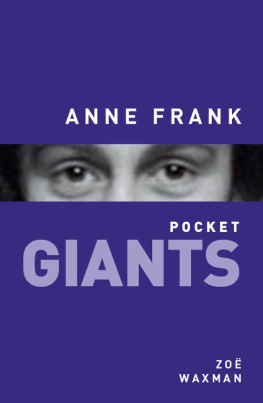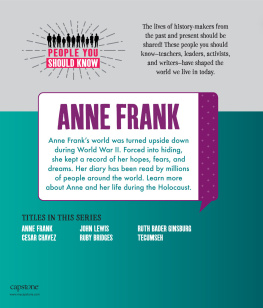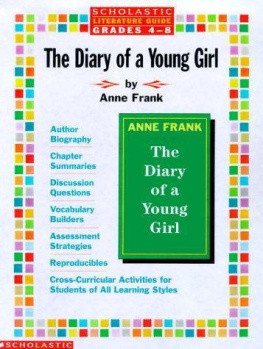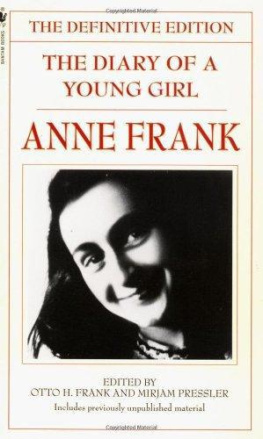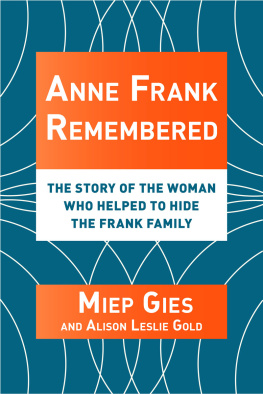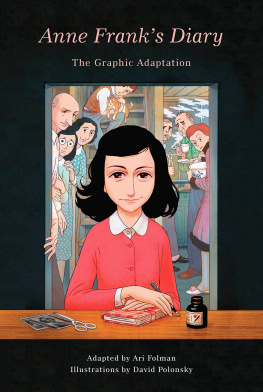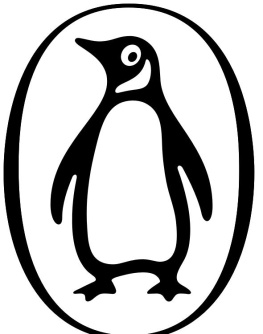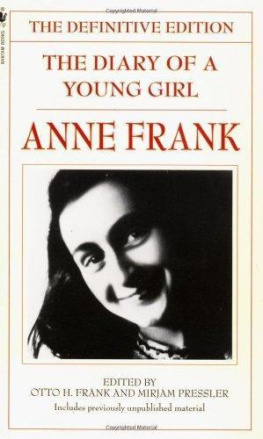The Diary of Anne Frank is one of the most famous and best-selling books of all time. Yet the girl who wrote it remains an enigma. The real Anne Frank has been hidden again, lost behind the phenomenon of her posthumously published diary.
This concise biography rediscovers Anne. It tells her story from its beginning to its untimely end. It places her life within the wider context of the Holocaust and also explores her afterlife seeking to explain why, over seventy years after the events it chronicles, Anne Franks diary still speaks to us today.
Introduction
I can shake off everything if I write; my sorrows disappear, my courage is reborn.
Wednesday, 5 April 1944
In honour of the eightieth birthday of Anne Frank, the British Anne Frank Trust an organisation which attempts to tackle bigotry and prejudice in contemporary Britain commissioned a pictorial representation of what she might have looked like aged 80. The image shows a rather beautiful woman, displaying the type of gentle wisdom and grace we like to think comes with age and experience. The trouble with the image, which deploys the techniques that are used to artificially age people who have gone missing, is that it bears little relation to what we actually know of the short, sad life of a girl who died of typhus and starvation at just 15 years old in BergenBelsen. We cannot know whether or not Anne Frank would have fulfilled her early potential as a talented author or journalist, or how her character might have developed. Her surviving stepsister, Eva Schloss, whom she hardly knew, spoke of her surprise at the image, observing, I think she would have been more bitter and disappointed. I didnt see anything of this in the picture. This photograph and the comment it provoked are indicative of the type of polarised thinking which seems to characterise responses to the life of Anne Frank. Either she is portrayed as heroic and as an example of the triumph of the human spirit, or she is mourned as a tragic victim or icon of suffering.
Anne Franks fame rests on her diary. She used it a red and white chequered notebook which she chose herself as a present for her thirteenth birthday as a confidante. She named it Kitty and it truly did become her best friend. On the first page of the diary, Anne wrote: I hope I will be able to confide everything to you, as I have never been able to confide in anyone, and I hope that you will be a great source of comfort and support (Friday 12 June 1942). She wrote approximately twice a week and dated and signed each entry either Anne Frank or Anne.
The diary, originally written in Dutch and published in 1947 in Holland as Het Achterhuis: Dagboekbrieven 12 Juni 19421 Augustus 1944 ( The Secret Annexe: Diary-Letters 12 June 19421 August 1944 She now even has her own, unofficial, Facebook page.
Frank herself chose the title for the book, which she planned to publish after the war, remarking, The title alone would be enough to make people think it was a detective story (Wednesday 29 March 1944). The original publication title, however, was changed in the 1950 English language edition to Anne Frank: The Diary of a Young Girl. It was marketed as the work of an intelligent young girl whose life was tragically cut short. She was just 13 when she began her diary on 14 June 1942, and 15 when she died, becoming one of the at least 1.5 million Jewish children murdered during the Holocaust. Readers of all nationalities and ages felt drawn to Anne and her vivid descriptions of life within the confines of her hiding place. A play, The Diary of Anne Frank, written by the Hollywood husband-and-wife team Frances Goodrich and Albert Hackett, premiered on Broadway in 1955 with Marilyn Monroe in the audience, and won the Pulitzer Prize for Drama, the Tony Award for Best Play, and the New York Drama Critics Circle Award. It was exported all over the world and quickly gave rise to many film versions. In 1996 a feature-length documentary, Anne Frank: A Life Remembered, won an Academy Award for best documentary feature. The film contains a very brief sighting of Anne herself leaning out of an apartment window.
Many people had grown up identifying with Anne Frank to such an extent that they felt uncomfortable with the publication of De Dagboeken van Anne Frank , an almost unedited version of the diary produced in 1986 by the Netherlands State Institute for War Documentation. A 700-page English translation, The Diary of Anne Frank: The Critical Edition, appeared in 1989, reprinting nearly all the different versions of the diary and omitting only the five pages that Annes father, Otto Frank, deemed unsuitable for publication. It was then translated into German, French and Japanese, and a revised edition was published in Dutch and English in 2003. Willy Lindwers 1988 international Emmy Award-winning documentary, The Last Seven Months of Anne Frank , turned attention to Annes life after her capture. As Annes testimony stops before her arrest, Lindwers film is forced to rely on the memories of the Dutch women who knew Anne and her sister Margot in their final months.
Anne Franks appeal seems in little danger of dissipating. One biographer, Melissa Mller, actually calls herself an Anne Frank fan. As a child she was obsessed by Frank in the same way that other children become fascinated with popular music figures. Although the diary does chronicle the overcrowding, hunger and frustration endured whilst hiding from the Nazis above her fathers store in Amsterdam, it stops short of the familys deportation on 4 August 1944. Hence, the diary manages to retain at least to some extent the authors zest for life and what Frank herself calls her illogical gaiety.
This book seeks to look again at the life of Anne Frank a life that we might already think we know. The time is ripe for such an analysis. As the events of that era recede further into the past, we might finally be reaching a point from where we can attempt a more nuanced approach to victimhood during the Holocaust. This means moving away from sentimentality, the sacralising tendency and hushed tones often used to talk about the victims of the Nazi genocide. Without doubt, the life of Anne Frank is a tragedy. She witnessed the murder of thousands of men, women and children; she experienced the murder of her mother; and then watched her sister starve to death before succumbing to the same fate herself. Her death, like every one of the 11 million victims of the Nazi genocide 6 million of them Jews represents a life cruelly and brutally extinguished. Yet Frank, who became increasingly aware of the inevitability of her fate, somehow eschewed pathos, and instead produced a most remarkable book. Importantly, she saw her work not just as a private journal, but as an important historical document which would need to be analysed and interpreted in the future.
Whilst the most frequently cited of Franks statements is I still believe, in spite of everything, that people are truly good at heart (Saturday 15 July 1944), we need to remember that she died a horrible death. We need to remember Anne Frank as a real person: not just a symbol of humanity or the Holocaust but an important figure and witness in her own right.
Notes
Frank, O. H. and Pressler, M. (eds), The Diary of a Young Girl: The Definitive Edition , (London, 1997)
Daily Telegraph , 6 June 2009.
Secret Annexe is not the exact translation. Het Achterhuis literally means the house behind.
Cited in Kirshenblatt-Gimblett, B. & Shandler, J. (eds), Anne Frank Unbound: Media, Imagination, Memory (Indiana University Press, 2002), p. 2.

